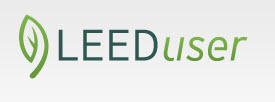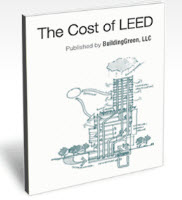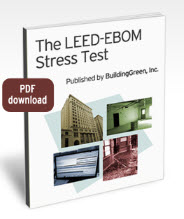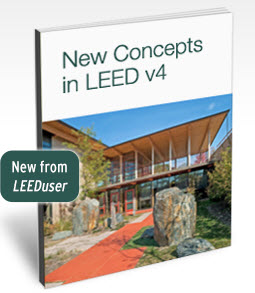What is LEEDuser? In a nutshell, LEEDuser is an independent website offering supporting information, including templates, spreadsheets and sample completed documentation forms, to give LEED project teams a leg up. LEEDuser also offers an amazing forum where you can ask (and answer) just about any question on almost any LEED topic.
Prepare. Organize. Document. Achieve.
With a 92 percent renewal rate, LEEDuser membership is a mission-critical project certification resource for individuals and project teams.
For only $99.95/year you can get your membership going – it’s well worth the price. (I know, I’ve been a member for more than 2 years now…) As a bonus for registering, we’ve worked with LEEDuser so you get some extra bonuses just for joining. Check out these FREE reports you can get just for joining LEEDuser through SucceedAtLEED.com
Get a Handle on the Cost of a LEED Project
Any number of studies have tried to predict overall cost impact of LEED. But only LEEDuser’s guide, The Cost of LEED-NC, gives you cost information on hundreds of specific technologies and approaches that teams are using right now to earn points in LEED-NC.
Going credit-by-credit through LEED-NC 2009, The Cost of LEED-NC features a list of “standard” approaches compared to “high performance” options, along with cost premiums for those options.
With The Cost of LEED-NC, you’ll be able to get a handle on your best options for achieving credits—and to understand the cost implications of those options.
Created by BuildingGreen with support from USGBC and a team of top LEED consultants including YR&G, LEEDuser’s sole focus is to help you prepare, organize, document and achieve every credit your project is aiming for—plus some you didn’t think were in reach.
You get The Cost of LEED for FREE when you join LEEDuser. Join LEEDuser today for only $99.95/year.
Start your LEED EBOM Readiness Review Today!
How ready is your project team for the challenging credits—like EAc3.2: Performance Measurement—System-Level Metering (17% achievement among certified projects) and SSc6: Stormwater Quantity Control (20% achievement)?
Start your project readiness review with this 85-page, credit-by-credit roadmap… and see where you stand with each LEED-EBOM credit:
* Points available, the credit’s achievement rate, and LEEDuser’s difficulty ratings
* A flow chart diagram for achieving the credit, along with specific action steps
* How to prepare your project team to meet key credit-specific challenges
Wheter you’re on your first LEED for Existing Buildings: Operation & Maintenance LEED project, or if you’ve already worked with LEED-EBOM 2009, you’ll find The LEED-EBOM Stress Test to be a useful reference tool to have as you manage your LEED project. Take it to your project team meetings and building walk-throughs and refer to it anytime you’re starting a new credit or prerequisite or a new project. This report will give you a quick assessment of what the credit is all about and how ready you are for trying to achieve it.
You get The LEED-EBOM Stress Test report for FREE when you join LEEDuser. Join LEEDuser today for only $99.95/year.
LEED v4 is a game changer. Understand the key concepts in 30 minutes or less.
BUG ratings? Really?
Previous versions of LEED have helped make FSC, commissioning and energy modeling practically household terms. But are you ready to add BUG ratings, LID infrastructure, BECx, and other terms to your design vocabulary?
Written for individual LEED practitioners as well as project teams, New Concepts in LEED v4 explains the key LEED v4 concepts and analyzes the impacts on credit requirements that will define your projects for years to come.
Closing the (mis-) information gap
New Concepts in LEED v4 analyzes LEED v4’s controversial approaches affecting the Materials and Resources (MR) category, including the new two-part credits aimed at creating market demand for transparency in building product ingredients.
The report clarifies the intent and workings of the new credits and provides clear guidance to the AEC community—while clearing up the confusion sown by players in the chemical and manufacturing industries.
Additional MR coverage includes analysis of the ambitious new whole-building life-cycle assessment (LCA) and building product disclosure and optimization credit options.
Get Full Details on Each Significant New Aspect of LEED v4
* How the new Integrative Design credit ties early design analysis to later phases of design and construction and into the occupancy phase
* Changes to the Sustainable Sites category, with details on the new rainwater management and light pollution reduction credits
* Within the Energy & Atmosphere category, a discussion of technical and cost considerations for the new Enhanced Commissioning credit—and the expansion of demand response and green power/carbon offset initiatives
* Changes in IEQ credits emphasizing modeling, performance testing and monitoring
* And more
BONUS!! Self-Report for One Continuing Education Unit
New Concepts in LEED v4 provides a great opportunity to self-report 1 GBCI CE hour toward the LEED Credential Maintenance Program.
You can get New Concepts in LEED v4 for FREE when you join LEEDuser for only $99.95/year.
Keeping Up With LEED 2009 is a Challenge.
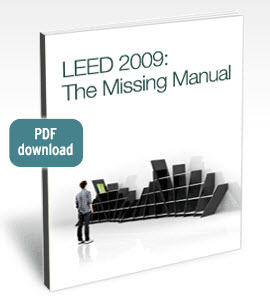 It’s difficult to keep up with all of the changes with LEED 2009. If you’re not routinely checking LEED addenda, interpretations, changes to ratings, etc. you’re missing out and LEED project management can become really cumbersome.
It’s difficult to keep up with all of the changes with LEED 2009. If you’re not routinely checking LEED addenda, interpretations, changes to ratings, etc. you’re missing out and LEED project management can become really cumbersome.
LEEDuser, one of the most popular LEED user groups around, has created a new all-in-one resource that puts all of the addenda, LEED Interpretations, review comments, frequently asked questions, core material in the LEED Reference Guide and countless other useful bits of information — all at your fingertips.
Introducing LEED 2009 NC: The Missing Manual.
LEED 2009: The Missing Manual is a Laser Guide to Hard-To-Find LEED Resources
There’s a wealth of resources at both LEEDuser’s and USGBC’s websites to help you prepare, organize, document and achieve every credit your project is aiming for. The LEED 2009 Missing Manual shows you how to find it and where to find it, with direct links to:
- Credit achievement rates
- Key interpretations
- Frequently asked questions for every LEED-NC 2009 credit
- Addenda
- Calculators
- LEED Checklists
- Key guidance documents and documentation submittal tips
We’ll also show you how to quickly find expert answers from among the tens of thousands of questions and comments available on LEEDuser’s credit forums — a vital resource for every LEED 2009 project.
Here is just a sample of the great informational material you’ll receive in this essential LEED 2009 manual:
SSc1: Site Selection
The project site is classified as “prime farmland,” but is in a developed area with buildings all around. Can I still comply with this credit? LEED does not have published exceptions to the prime farmland requirement. You would need to submit a CIR to get an official ruling. However, some projects have had success contacting the local USDA representative and requesting an evaluation to get an exemption due to the low probability that the land could be usable for agricultural purposes.
Our project site is in what FEMA refers to as “Zone D”—an area that has possible but undetermined flood hazards, as no analysis of flood hazards have been conducted. How can we tell if we comply with this credit? Seek the opinion of an equivalent local regulatory agency, or a professional hydrologist.
Is it possible to be exempted from the wetlands requirements under this credit if we protect or restore equivalent wetlands elsewhere? No, this is not an accepted compliance path. LEEDuser’s experts agree that you are unlikely to get traction with this due to the immediate and unsustainable impacts on local ecosystems and hydrology.
Is my site previously developed? Many projects have had questions about the definition of previously developed. Note that LEED 2009 projects have had the relevant definition updated by USGBC through a November 2011 addendum. Be sure to reference that definition.
Courtesy of LEED 2009: The Missing Manual
Free for LEEDuser members
Normally costing $79, LEED 2009: The Missing Manual is available free to all premium LEEDuser members.
If you’re not yet a LEEDuser member, you can become one at our regular $99.95 price and get LEED-NC 2009: The Missing Manual free at the same time. Your membership comes with a 100% money-back guarantee. Order today at LEEDUser.com.
LEEDuser’s 100% money-back guarantee
We’re confident that you’ll find LEEDuser an indispensable resource for getting your project certified. If at any time during the life of your membership you feel that LEEDuser isn’t a mission-critical asset, contact LEEDuser for a complete 100% refund of your $99.95 annual membership fee.


